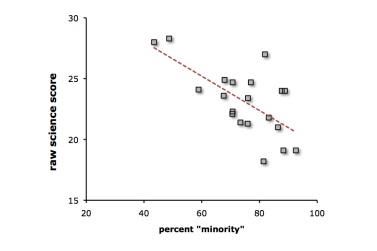A common dream for every educator is to start one’s own school. However, once you are invited to design a science magnet school, the tolerance for crazy ideas suddenly disappears and is replaced by a need to know exactly what the right thing is to do. One tactic is to look at science performance across a variety of schools in an effort to uncover features that might be essential for success.
This graph shows fifth grader performance on the annual  statewide science test. Each symbol represents a school within a single urban district with the percent of “minority” students (i.e., those who are not White) along the horizontal axis and science scores on the vertical axis. The statistical trend is that the scores go down as the proportion of minority students increases. What is surprising is how much variation there is in science performance. At the 80% mark we see substantial differences in scores — and the causes for this are intriguing.
statewide science test. Each symbol represents a school within a single urban district with the percent of “minority” students (i.e., those who are not White) along the horizontal axis and science scores on the vertical axis. The statistical trend is that the scores go down as the proportion of minority students increases. What is surprising is how much variation there is in science performance. At the 80% mark we see substantial differences in scores — and the causes for this are intriguing.
Those who work with statistics have an aversion for unusual data. Rather than throw outliers away, schools with performance far above what the equations predict are cause for investigation. That is how this project began. We wondered why schools with similar populations of students had such uneven performance in science. Even though the science test is given during the fifth grade, we felt the test measured more than what a child learned with one teacher during one school year. And this made us wonder whether the school as an organization could help explain the outliers in this data.